Under the hands of Japanese artist Fuji Hiroshi thousands of discarded plastic toys have been revived into unique and impressive works of art, displayed at the 'Plastic Era' exhibition in Hà Nội, carrying an important message.
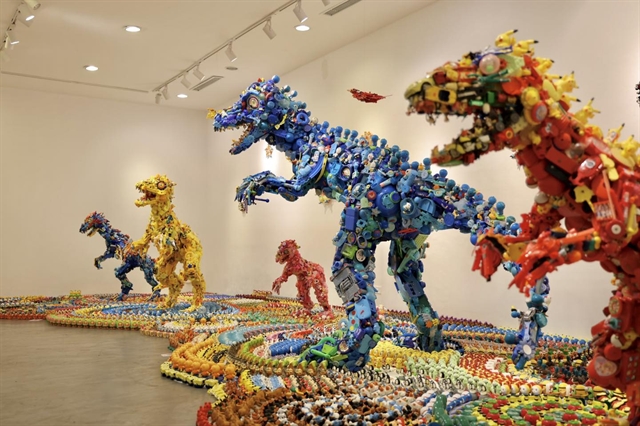
The 'Plastic Era' exhibition with works made of old plastic toys is ongoing in Hà Nội. Photos of Japan Foundation
HÀ NỘI — Under the creative hands of Japanese artist Fuji Hiroshi thousands of plastic toys have been reconfigured into unique and impressive works of art, part of the 'Plastic Era' exhibition in Hà Nội.
Staged in the centre of the city, the exhibition is for both kids and grown-ups, with dazzling large-scale installations and sculptures of dinosaurs and other animals.
The models are shaped from large volumes of unwanted toys, including famous animated characters such as Doraemon and Pikachu, becoming eye-catching pieces of art on an impressively big scale.
All have been created using Hiroshi's old toy collection projects.
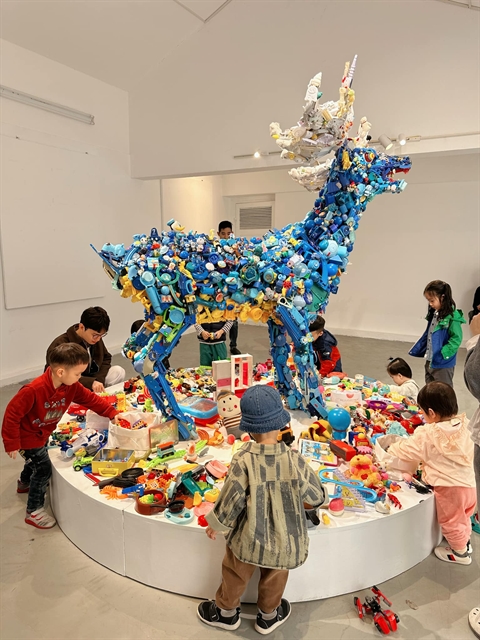
The hands-on exhibition area has proved one of the most popular places for children since its opening.
A highlight of the exhibition is the unique interactive space, allowing visitors to freely explore and experience the toys before they have been 're-fashioned' - something unlike traditional exhibitions.
Instead of just watching and admiring the work, people are able to directly touch the pieces, helping them, especially children, clearly feel their materials, shapes and textures.
The works are created with the desire to convey messages about changing consumer behaviours and protecting the environment.
"My child is very excited to see such beautiful and unique plastic animals here. He curiously runs around, points, and continuously asks: 'What is this made of, mum?', 'How can the artist put so many toys together?'" said Lê Minh Hoan, the mother of a six-year-old boy.
"The exhibition not only delights children, but also impresses adults. I have been aware of pollution from plastics, but after this will seriously review my plastic consumption behaviour.
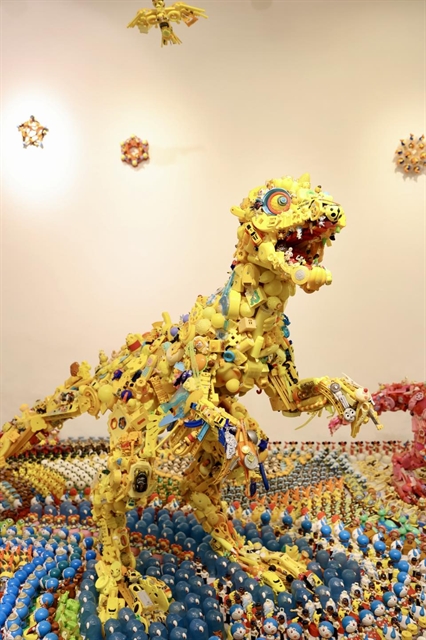
A dinosaur made of many old Doraemons and Pikachu.
"This artistic space is both brilliant in the terms of art and education. There are no tiring boards about information, numbers and wasteful warnings, but giant, colourful, beautiful and cute works that give viewers unique visual experience and offer that 'wow' factor.
"If you are looking for a place to take your children to play, but where there is also something they can learn, this place will be an experience worth trying, especially because it is free!" she said.
Impressed by the way artist Hiroshi creates art works, the painter Vũ Xuân Đông praised his creativity and his ability to connect his message with children.
“His idea is unique. He uses toys – something close to children – to create highly educational works of art. This is a very difficult audience to reach, but the way he does it is very simple and effective," he said.
"He connects cartoon characters, creating an artistic world with a strong Japanese style, making the exhibition's message both attractive and easily accessible to the younger generation.”
Fuji has long felt that there was a wrongness in products made of plastic, which mushroomed into part of our daily lives since the 1970s.
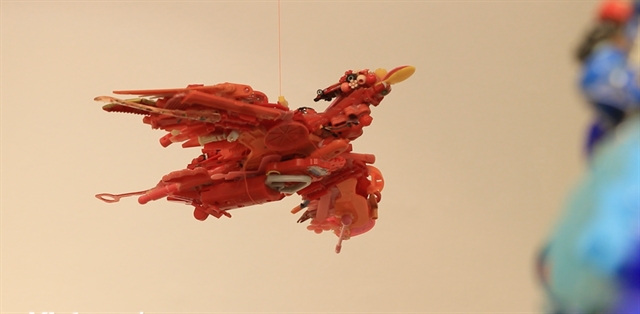
A plastic bird at the exhibition.
In 1997, he eventually started to keep and collect discarded plastic products and toys at home, resulting in the creation of his long-run project 'Kaekko Bazar', a platform where children can exchange their unwanted toys.
Fuji found out that, through the project, while attractive second-hand toys were always immediately taken by kids, broken plastic toys and toys, such as those distributed in a mass giveaways through fast-food chains, were left behind and not swapped.
The number of unwanted toys, mostly plastic toys, which Fuji has collected, has now reached over 50,000 items. But that is just a tip of the iceberg. Fuji says that over-produced and consumed plastic products are thrown away in a large quantities in the world. They flow into rivers by floods and spread widely in the ocean, which causes a great negative impact on marine life.
With the fact that crude oil, the raw material of plastic, is produced from the corpse of creatures such as dinosaurs, the exhibition, in which Fuji transformed unwanted toys into items of value not only amused us with its colourful visual impact, but also inspired us to consider the role of plastic in our lives, shedding light on our collective consumption and waste.
“My original intention was to just collect toys, but then I realised that I needed to do something meaningful with these plastic items," said Hiroshi.
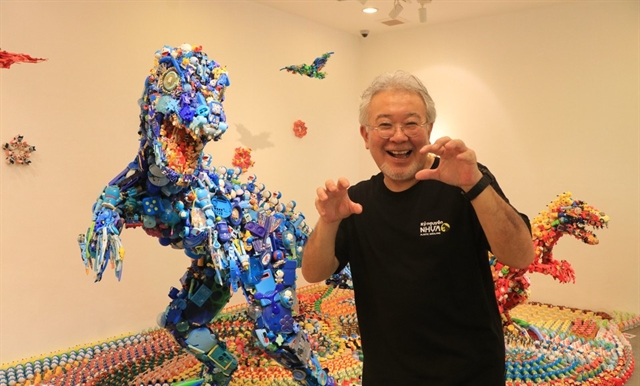
Japanese artist Fuji Hiroshi poses alongside his work.
"Nowadays, plastic is used everywhere in the world and it cannot decompose on its own. I thought of the image of dinosaurs, ancient creatures that existed for millions of years.
"Therefore, I chose dinosaurs as the symbols for my plastic works. Children are not fully aware of the negative impacts of plastic on the environment, but I hope that through this exhibition, they will understand more about the problem of pollution.”
According to statistics from the Ministry of Agriculture and Environment, about 1.8 million tonnes of plastic waste is discharged into the environment, of which 0.28-0.73 million tonnes is discharged directly into the sea, but only 27 per cent of this is recycled and reused by facilities and businesses in Việt Nam every year.
The 'Plastic Era' exhibit is open every day until June 1 at the Japan Foundation Center for Cultural Exchange, at No 27 Quang Trung Street, Hoàn Kiếm District. VNS